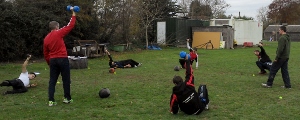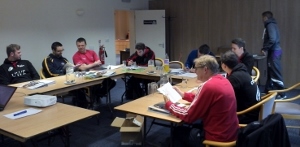How to start coaching strength and conditioning
“How can you demonstrate if you have never done the exercise?”
 was one of the questions I asked the candidates on the Level 1 strength and conditioning course at the weekend.
was one of the questions I asked the candidates on the Level 1 strength and conditioning course at the weekend.
Reading a text book or journal is one thing, setting up a good plan is another. Delivering and executing that plan, then being able to adapt it is where coaching is difficult.
There was a blend of youth and experience on the course, with 5 students and 5 people who work. As always, I started off with trying to establish coaching language used in order to dismiss folklore and create better understanding.
 However, one of the candidates thought that my insistence on using simple coaching cues actually complicates matters! This came up in our discussion on how to communicate effectively when coaching.
However, one of the candidates thought that my insistence on using simple coaching cues actually complicates matters! This came up in our discussion on how to communicate effectively when coaching.
Once again, language is important so we avoid doing “rotator cuff” dumbbell exercises (which have nothing to do with our rotator cuff works in real life) rather than thinking about the movements that our sport requires and training our shoulders accordingly (shoulder exercise video)
Walking the walk
As usual, over half the course was based on practical learning and delivery. I try to work from the premise of creating structural integrity with our athletes, then progressing to developing movement efficiency.
It is quite concerning to see young people who are in pain and who lack the ability to perform fundamental movements such as squatting, skipping and balancing on one leg.
Without these basic skills, it is hard to move fast, or sustain movement without getting injured. I took the candidates through a series of exercises and progressions that will help remedy this. We then applied this in speed and agility work.
 Again, I kept this simple, but concentrated on coaching it thoroughly. The principles can then be applied to whatever other drill the candidates choose to use in their environments.
Again, I kept this simple, but concentrated on coaching it thoroughly. The principles can then be applied to whatever other drill the candidates choose to use in their environments.
I have to be patient and realise that young people are a product of their environment and are just starting out on their coaching pathway.
Further reading:
- 5 tips on how to get started in strength and conditioning coaching
- How to prevent ACL injuries
- 8 tips on how to move like an athlete

A great course learnt lots from James and the other candidates. Looking forward to practicing, developing and applying the learning in the assessment in January. Many thanks James. Tim
Thanks Tim, really enjoyed your input into the discussions. Thanks for sharing.
I have just been to the gym and chatted to other coaches about the benefits of this course. I can’t praise you enough. It has opened my eyes and stimulated my enthusiasm. I have told other coaches they NEED to do this course to benefit the whole of the junior rugby squad and in future years the quality of players in the first team and beyond. Well worth the 250 mile drive. Anyway, I have a warm up session to plan for Wednesday night!
See you in January.
Carl
Thanks Carl,
and thanks for making the effort to come down. Glad to see you are enthused.Really good to hear about your experience on the course.
James and fellow attendees, thanks for making it a great course, with plenty of interaction, stacks of info and resources, practical experience and FUN (but if I see another band around my ankles in the near future I won’t be too pleased.) Thanks to everyone who made it a success. Gavin
Thanks Gavin. You held up well, but I should have hidden the mini bands on Sunday afternoon! Great enthusiasm and insights from you.
nice read!
hi
[…] a level 1 strength and conditioning course […]